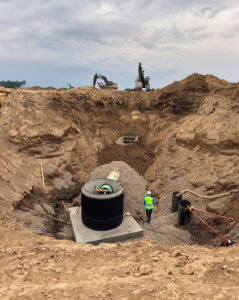Understanding Underdrain Systems During Project Development
Colorado is home to some of the largest river systems in the country: the Colorado River, the Rio Grande, the Platte River, and the Arkansas River. These river systems, canals, springs, lakes/ponds, and irrigation ditches, contribute to increased groundwater. Underdrain systems reduce or control these groundwater elevations and prevent damage to below-ground infrastructure and are often an important design feature in Colorado. It is crucial to establish if your project needs an underdrain system and how it integrates with your project’s design.
 An underdrain system is a series of underground perforated pipes designed to reduce or control groundwater elevations by absorbing water and directing it to a surface outlet. They are used in many cases and are commonly installed to ensure stable infrastructure for building foundations. In the early planning process, developers often do not know if their project needs an underdrain system. Galloway’s water resources team has over 75 years of combined experience and helps clients determine if the system is required, explore alternatives, and navigate water rights.
An underdrain system is a series of underground perforated pipes designed to reduce or control groundwater elevations by absorbing water and directing it to a surface outlet. They are used in many cases and are commonly installed to ensure stable infrastructure for building foundations. In the early planning process, developers often do not know if their project needs an underdrain system. Galloway’s water resources team has over 75 years of combined experience and helps clients determine if the system is required, explore alternatives, and navigate water rights.
Developments typically need an underdrain system with a high or varying groundwater table caused by nearby rivers, canals, springs, lakes/ponds, and irrigation ditches. Our team establishes well-monitoring programs to measure the groundwater and evaluate its annual cycle. Existing groundwater well data is also collected to analyze soil information, water elevation, and the location, efficiency, and installation date of existing wells. Knowing the location of existing wells is a significant part of the permitting process as it prohibits you from impacting any wells within 600 ft of the underdrain system. This information and geotechnical boring information can create a groundwater model that establishes how the system would work, capacity, discharge rate, and safety factors. If basements are part of the design, they require at least 10 feet of depth, which is also factored into the design of the underdrain system.
The groundwater model calculations present our clients’ options – an underdrain system, fill, or a combination of both. The best solution is determined based on a cost- benefit analysis. Adding construction fill to increase the height of your structure’s foundation may be less cost-effective than installing an underdrain system, as the cost of fill and hauling it can be expensive.
benefit analysis. Adding construction fill to increase the height of your structure’s foundation may be less cost-effective than installing an underdrain system, as the cost of fill and hauling it can be expensive.
Water Resources Team Manager Chris Pauley emphasizes the importance of noting that there are always underlying water rights associated with any underdrain system, and there are strict regulations and permits to ensure they are maintained. Most underdrain systems are optimally designed to have a gravity outfall. However, if the receiving river is far away or the collected water will drain to a different river, you might have to reroute the underdrain outfall, build a new outfall, or add a lift station. Whatever your underdrain needs, Galloway’s team is equipped with the knowledge to ensure your system is efficient, cost-effective, and adheres to water rights.
Work With Us
We are nationally recognized and locally preferred. We would love to work with you on your next project.
Contact Us